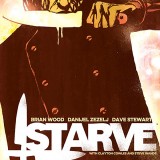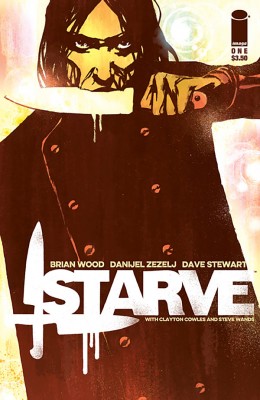
COMIC BOOK REVIEW: Starve #1 – Tastes of Reality
Raves
Rants
Brian Wood delivers another hard hitting, biting social commentary and brutal analysis on the on-going phenomena of “reality-television”, the continuing disparity of two economic forces, and the rottenness of unbridled capitalism in the guise of culinary cuisine in Starve #1, with Daniel Zezelj and Dave Stewart. Wood hands on present a bleak not-so-distant future where food becomes […]
Brian Wood delivers another hard hitting, biting social commentary and brutal analysis on the on-going phenomena of “reality-television”, the continuing disparity of two economic forces, and the rottenness of unbridled capitalism in the guise of culinary cuisine in Starve #1, with Daniel Zezelj and Dave Stewart. Wood hands on present a bleak not-so-distant future where food becomes the barometer between the elite and the hoi polloi in the carnival presentation in the reality-television aptly called STARVE.
Don’t let the title fool you. Yes, it is synonymous with hunger and, well, food. But the writer is anything but an optimist in crafting stories that make our sense of social justice and responsibility, equality and consciousness put on the table and stare these progressive and enlightened concepts harder and reflectively. Indeed, this premier issue already set the tone and scope of what should a Brian Wood work that is worth reading, reflecting the current state of affairs, and most significantly, see our cultural practices more critically than ever.
True to Wood’s formidable and uncompromising take on what is happening to our global and American settings, the writer wants us readers to ask some simple yet difficult questions: what makes the mundane appetizing; what constitutes happiness; what makes us “real” from “reel”; and what is the limit of being hungry and sate”? Reading this ruthless critique makes me reflect once again Wood’s consistent critical stances in some of his finest indie titles like DMZ and The Massive. Also, Wood’s love to America is ironically the source of his brutal appraisal on what is really wrong to his beloved country. The Land of the Free, how so ironic truly! Freedom from oppression, poverty; freedom to pursue happiness; and the right of dignity are some of the libertarian themes of fundamental or human rights that Wood attempts to explore more while illustrating the stark and uncomfortable realities America (and the rest of the world) would and will confront if the US takes little notice on what is going on in its socio-economic and cultural spheres. Food is Wood’s latest paradigm to heighten his cultural-political attacks on the continuing disparities of anything he sees wrong. The mention of “common meat” is striking and it connotes a broader perspective of the flesh as a commodity of the people, by the people, and for the people. Food is a powerful metaphor of what is wrong with our selves right now. Karl Marx’s dictum of the dominance of the few on the limited resources is equivalent to its control of the fates of almost everyone rings true further. Gramsci further extends Marx’s economic deterministic stance to anything cultural or the things we do and inherent. Food becomes scarcer; the powerful elites dominate the political-economic institutions, the bourgeoisies dictate the standards of haute couture, and the hoi polloi is being unaware dictated on what to do: SURVIVE. And they starve for more!
Readers of Warren Ellis’s TRANSMETROPOLITAN would be familiarized with STARVE’s protagonist Gavin Cruikshank, a has-been top culinary chef. Like Ellis’s Spider Jerusalem, Gavin is living in the seedy Southeast Asian society (most probably Thailand due to the Muay Tai matches scenes). He lives to the fullest, almost forgetting the luxurious life he once had. But similar to the uncompromising reporter, the former master chef soon finds himself needed. That’s where the journey, the exploration and the conflict begin. Relevant themes like climate change, the stock market collapse or the bubble burst, and corporate takeovers or privatizations are so undeniably strong that mere mentions of these resonate so loudly even the existence of economic polarities exists. Moreover, social institutions of marriage, familial ties, and the legal system are cleverly interjected to ensure Wood’s overall master plan of fulfilling the critical commentaries he wants to showcase. Gavin’s motivations are strengthened by these obstacles, particularly the full-knowledge of creating the monster that is STARVE in the first place that leads to the paradigm of socio-economic agent of alienation—the process of “dehumanization” via food! He is the alpha and therefore, he must be the omega. The writer makes sure he grabs the readers’ attention heads-on with this premier issue. STARVE could be a powerful series than his previous works if he continues tackling these trends and themes without restraints.
Furthermore, what this first issue stands out is Wood’s other creative team members’ utilization of minimal and jarring angular illustrations, the dark contrasts that signify the gloominess and divisiveness of the societies, and the emphases of words that really hit the nails of the coffin that is SOCIETY’s GREAT DIVIDE. Moreover, the paneling is superbly executed and even the intricate details in the faces of every character should be taken seriously and looked upon the emotional spectrums that are beyond Wood’s brilliant critical deconstruction of the hyped reality television. The most prominent color, red, serves the catalyst or the mover of what the rest of series holds. Just shown in three last pages, that color represents and symbolizes the crux of the writer’s dislikes about his beloved America. Yet, the main character does the undesirable anyway, similar to Wood’s archetypes in DMZ and Massive: reluctant, tiers of loose ends, humans.
Similar to majority of Image titles, Starve #1 is rightfully labeled as “Mature” due to the fact that food is highlighted here would something make some of us vomit upon learning in first reading. Graphic, brutal, unapologetic, Wood et al remain focused on their objectives abovementioned. True to his metaphor of food, that “common meat” is eaten as a staple dish in many parts of Asia (like China for example). We Filipinos are aware of this “fact” of life, and we even have some culinary recipes for that kind of meat (i.e. caldereta and azucena). But still, many of us may cringe on that one. So, read STARVE at your own risk! Zezelj and Stewart’s art may even turn off some casual readers due to their uneven angular perspectives, especially their take on minimal coloring that can be more depressing in one than even sating one’s appetite. What more is their crimson application on the “common meat” and the parts deliberately left out to prove the creative team’s point!
Starve #1 proves once again that comics are truly gearing to more mature and daring direction that independent comic publishers like Image Comics and others unleash. It also presents the direct and confrontational approach for creators like Wood and others to show the readers the present day problems that need serious actions/remedies from the central powers and the society itself through the usual template of science-fiction: critiquing the present by showing the possible future. It even illuminates the power of the comic medium of highlighting FOOD as the paragon of social, economic, political and cultural dysfunctional and eventual malfunctioned indicator if the ruling classes and the cultural elites never ever learn the mistakes of the past. Wood et al give us already the hors d’oeuvre but Starve #1 reads like the main course alright. Are they going to treat us some tasteless desserts in succeeding chapters? I hope Wood et al provide us more to starve on… EAT THIS!



















